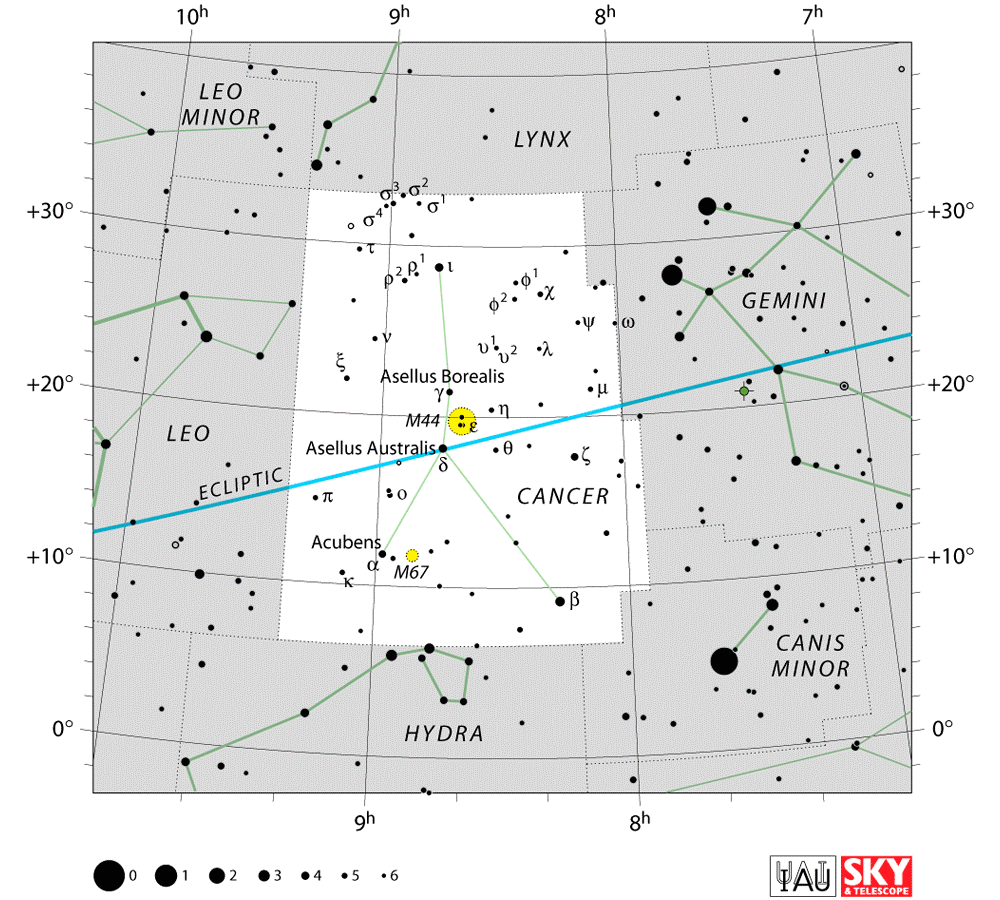






In mythology, Cancer is associated with the crab in the story of the Twelve Labours of Heracles (represented by the Hercules constellation). In the myth, Hera sends the crab to distract Hercules while the hero is fighting the Lernaean Hydra, the serpent-like beast with many heads and poisonous breath, represented by Hydra constellation. When the crab tries to kill Hercules, Hercules kicks it all the way to the stars.
In another version, the crab gets crushed instead and Hera, a sworn enemy of Hercules, places it in the sky for its efforts. However, she places the crab in a region of the sky that has no bright stars, because despite its efforts, the crab was not successful in accomplishing the task. Cancer does not have any stars brighter than fourth magnitude.

Cancer
Cancer (“the crab”) is a zodiac constellations, meaning it lies within the ecliptic path that the Sun, Moon and planets travel within each year in the celestial heavens. It is arguably the constellation that looks the least like the object it depicts, and is also the faintest of the 12 zodiacal constellations, with its brightest star, Al Tarf, of just fourth magnitude.
Location

It looks more like a faint, upside-down Y.
Cancer is visible in the Northern Hemisphere in the early spring. It can be seen in the Southern Hemisphere during autumn. The Cancer constellation occupies an area of 506 square degrees.
-
Right ascension: 9 hours
-
Declination: 20 degrees
-
Best seen between latitudes 90 degrees and minus 60degrees
-
Visibility is best during March at 9 p.m.
Deep Sky Objects in Cancer
Beehive Cluster (Praesepe, Messier 44, M44, NGC 2632, Cr 189)
-
The Beehive Cluster is an open star cluster about 577 light years from Earth. It is one of the nearest and most populated open clusters to the solar system. It has an apparent magnitude of 3.7 and its estimated age is 600 million years.
-
The Beehive Cluster is also called Praesepe, which means “the manger” in Latin.
-
The cluster is visible to the naked eye. The Greek astronomer Ptolemy observed it and called it “the nebulous mass in the breast of Cancer.” Galileo was the first to see in through a telescope in 1609, and Charles Messier added the cluster to his catalogue in 1769.
-
Praesepe contains at least a thousand stars. More than a half of them (63%) are red dwarfs, and about a third (30%) of the stars are Sun-like, classified as F, G and K-class stars.
-
The brightest stars in the cluster are blue-white in colour and with magnitudes ranging between 6 and 6.5.
Mythology
Previous
Next

Messier 67 (M67, NGC 2682)
-
Messier 67 is an open cluster. It is one of the oldest open clusters known. Its estimated age is between 3.2 and 5 billion years.
-
The cluster was discovered by the German astronomer Johann Gottfried Koehler in 1779. It has an apparent magnitude of 6.1.
-
M67 contains over 100 stars similar to the Sun and a number of red giants. Almost all the stars in the cluster are roughly at the same distance and of the same age (with the exception of 30 or so blue stragglers), which makes M67 one of the most observed and studied objects by those studying stellar evolution.

NGC 2775 (Caldwell 48)
-
NGC 2775 is a spiral galaxy, approximately 55.5 million light years from Earth. It has an apparent magnitude of 11.03. The galaxy was discovered by William Herschel in 1783. It has multiple spiral arms with few HII regions, which means there was recent star forming activity occurring in it.
NGC 2535 & NGC 2536
-
NGC 2535 and NGC 2536 are spiral galaxies in Cancer that are interacting with each other. NGC 2535 is an unbarred spiral with an apparent magnitude of 16.9, while NGC 2536 is a barred spiral galaxy with a magnitude of 14.6.
NGC 2500
-
NGC 2500 is a barred spiral galaxy, about 33 million light years distant, with an apparent magnitude of 12.2. It has an H II nucleus. The galaxy was discovered in the late 18th century by Friedrich Wilhelm Herschel. It belongs to the NGC 2841 group of galaxies, along with NGC 2537, NGC 2541, and NGC 2552 in the constellation Lynx.
NGC 2608 (Arp 12)
-
NGC 2608 is a barred spiral galaxy, 62,000 light years across, with an apparent magnitude of 13.01. It is classified as SB(s)b, which means that its spiral arms wind moderately around the prominent central bar. NGC 2608 is considered a grand design spiral galaxy. It is approximately 93 million light years distant.
